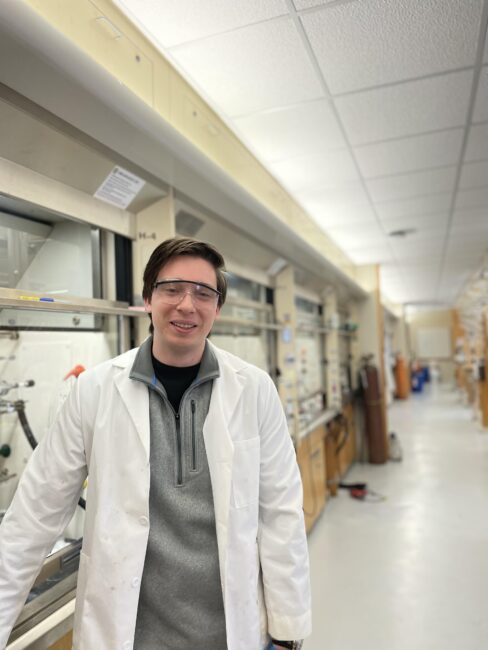Researcher Highlight: Andrey Shults

Andrey Shults, 4th year Chemistry PhD Candidate in the Macdonald Lab.
Summary of Research:
My research focuses on the synthesis of various metal chalcogenide nanoparticles and the mechanistic understanding of their formation. Just as with graphite and diamond, the polymorphs of carbon, the two different elements of a metal chalcogenide can combine in different ratios and assume various geometrical positions in the nanocrystal. This phenomenon gives rise to countless physical and chemical properties. As such, nanoparticles have been found to be useful in a wide range of applications. While engineers may be using them for the manufacturing of batteries, semiconductors, and solar cells, the researchers in the medical field may be interested in nanocarriers for various medicines or in magnetic nanoparticles capable of destroying cancer cells.
In the Macdonald Lab, we learn how to control the formation of one nanoparticle phase over the other. Through changing reaction parameters such as reaction temperature and time; choice of metal/nonmetal precursor and solvent; and precursor addition rate we have been able to build patterns and learn more about how nanoparticles form. In my first work, we looked at the formation of transition metal sulfides in the presence of sodium oleate, a very common reagent in nanoparticle synthesis. Due to its high potential as a ligand and its high boiling point, sodium oleate has been widely used to aid in the formation of various nanoparticles. We learned that as we increased the concentration of sodium oleate in the reaction vessel, the content of readily available sulfur decreased resulting in the formation of sulfur poor phases. We later realized that sodium oleate was reacting with thiourea, our sulfur precursor, converting it into a less reactive sulfur source, which explained the formation of sulfur poor phases. My current work is very similar synthetically but has to do with different systems: iron selenides and chromium tellurides.
Our hope is to achieve consistent and repeatable phase control of the metal chalcogenide phases. While we optimize the conditions for pure phase synthesis, it is up to our colleagues in physics, engineering, and biology to apply these nanoparticles to novel and valuable technologies.
VINSE Story:
Being in the Macdonald lab, I have been heavily involved with VINSE. Anywhere from fostering exciting collaborations to organizing fun events, VINSE has become a part of my graduate school life. The first work mentioned would not have been possible without the contribution from Caldwell Lab. In the earlier stages of the project, we needed an instrument that could analyze gaseous byproducts while the reaction was being heated to over 200°C. It wasn’t until we made contact with Dr. Joshua Caldwell that we realized he had the exact instrument we were looking for. Their access to in-situ gas FTIR made it possible to recognize the mechanism behind metal sulfide nanoparticle formations. This process, of course, took several attempts to perfect. Between having to move a boxful of glassware between two building and worrying about smelly gases filling up the lab, it took some time before we were able to optimize the method. With the help of the graduate student (at the time), Guanyu Lu, we were finally able to run our first sets of experiments which led us to the final hypothesis of the paper. I am very grateful and happy for their support; and, in the future, I am hoping to do more collaborations with groups outside of chemistry.
Contact: Andrey Shults
